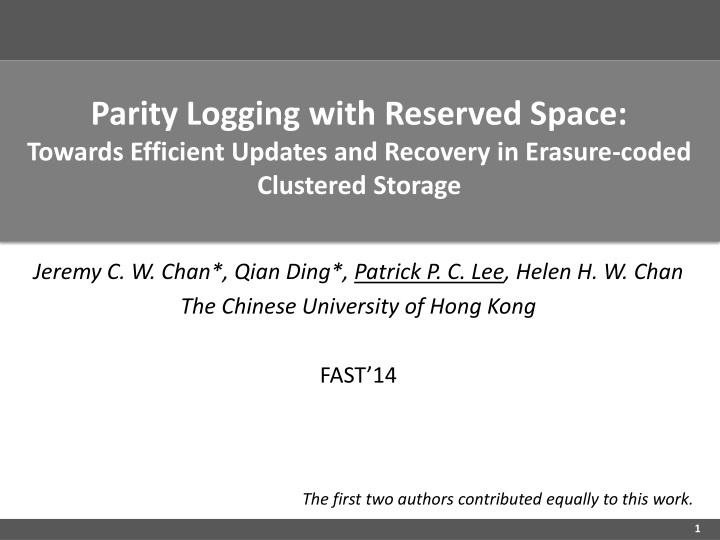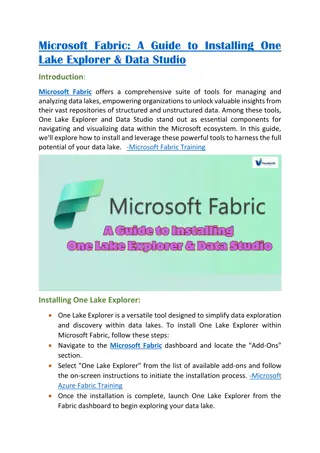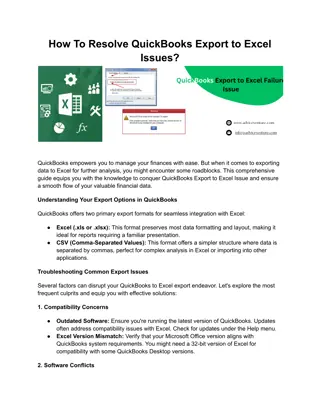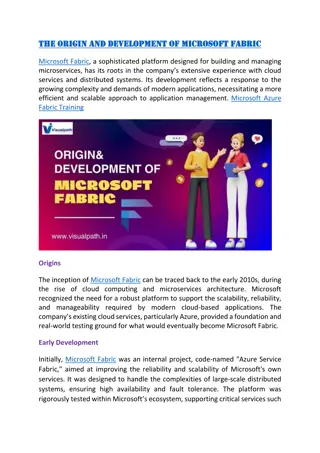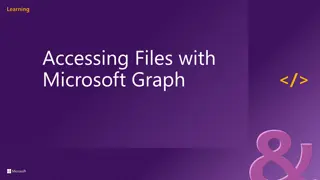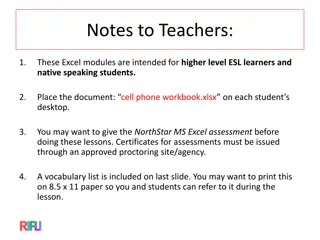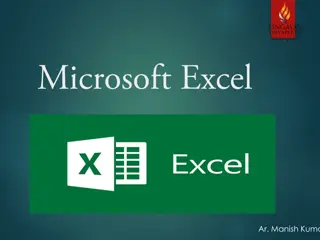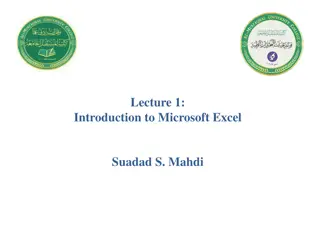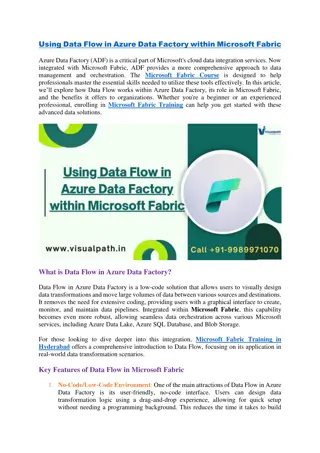Microsoft Excel - Powerful Spreadsheet Software
Microsoft Excel is a versatile spreadsheet application developed by Microsoft, utilized for various tasks such as data organization, financial analysis, accounting, and more. It features calculation capabilities, graphing tools, pivot tables, and a macro programming language for automation. Excel is widely used in businesses of all sizes for data management and analysis. On the other hand, Microsoft Access is a database management system that combines a relational database engine with user-friendly interface tools. It is ideal for storing data in table format, managing accounts, comparing data, creating database websites, and developing applications for small businesses or personal use.
Download Presentation

Please find below an Image/Link to download the presentation.
The content on the website is provided AS IS for your information and personal use only. It may not be sold, licensed, or shared on other websites without obtaining consent from the author.If you encounter any issues during the download, it is possible that the publisher has removed the file from their server.
You are allowed to download the files provided on this website for personal or commercial use, subject to the condition that they are used lawfully. All files are the property of their respective owners.
The content on the website is provided AS IS for your information and personal use only. It may not be sold, licensed, or shared on other websites without obtaining consent from the author.
E N D
Presentation Transcript
Parity Logging with Reserved Space: Towards Efficient Updates and Recovery in Erasure-coded Clustered Storage Jeremy C. W. Chan*, Qian Ding*, Patrick P. C. Lee, Helen H. W. Chan The Chinese University of Hong Kong FAST 14 The first two authors contributed equally to this work. 1
Motivation Clustered storage systems provide scalable storage by striping data across multiple nodes e.g., GFS, HDFS, Azure, Ceph, Panasas, Lustre, etc. Maintain data availability with redundancy Replication Erasure coding 2
Motivation With explosive data growth, enterprises move to erasure-coded storage to save footprints and cost e.g., 3-way replication has 200% overhead; erasure coding can reduce overhead to 33% [Huang, ATC 12] Erasure coding recap: Encodes data chunks to create parity chunks Any subset of data/parity chunks can recover original data chunks Erasure coding introduces two challenges: (1) updates and (2) recovery/degraded reads 3
Challenges 1. Updates are expensive When a data chunk is updated, its encoded parity chunks need to be updated Two update approaches: In-place updates: overwrites existing chunks Log-based updates: appends changes 4
Challenges 2. Recovery/degraded reads are expensive Failures are common Data may be permanently loss due to crashes 90% of failures are transient (e.g., reboots, power loss, network connectivity loss, stragglers) [Ford, OSDI 10] Recovery/degraded read approach: Reads enough data and parity chunks Reconstructs lost/unavailable chunks 5
Challenges How to achieve both efficient updates and fast recovery in clustered storage systems? Target scenario: Server workloads with frequent updates Commodity configurations with frequent failures Disk-based storage Potential bottlenecks in clustered storage systems Network I/O Disk I/O 6
Our Contributions Propose parity-logging with reserved space Uses hybrid in-place and log-based updates Puts deltas in a reserved space next to parity chunks to mitigate disk seeks Predicts and reclaims reserved space in workload-aware manner Achieves both efficient updates and fast recovery Build a clustered storage system prototype CodFS Incorporates different erasure coding and update schemes Released as open-source software Conduct extensive trace-driven testbed experiments 7
Background: Trace Analysis MSR Cambridge traces Block-level I/O traces captured by Microsoft Research Cambridge in 2007 36 volumes (179 disks) on 13 servers Workloads including home directories and project directories Harvard NFS traces (DEAS03) NFS requests/responses of a NetApp file server in 2003 Mixed workloads including email, research and development 8
MSR Trace Analysis Distribution of update size in 10 volumes of MSR Cambridge traces Updates are small All updates are smaller than 512KB 8 in 10 volumes show more than 60% of tiny updates (<4KB) 9
MSR Trace Analysis Updates are intensive 9 in 10 volumes show more than 90% update writes over all writes Update coverage varies Measured by the fraction of WSS that is updated at least once throughout the trace period Large variation among different workloads need a dynamic algorithm for handling updates Similar observations for Harvard traces 10
Objective #1: Efficient handling of small, intensive updates in an erasure-coded clustered storage 11
Saving Network Traffic in Parity Updates Linear combination with some encoding coefficient A B C P applying the same encoding coefficient Update A A is equivalent to P B C A P P parity delta ( A) Make use of linearity of erasure coding CodFS reduces network traffic by only sending parity delta Question: How to save data update (A ) and parity delta ( A) on disk? 12
Update Approach #1: in-place updates (overwrite) Used in host-based file systems (e.g., NTFS and ext4) Also used for parity updates in RAID systems Update A Disk Disk A B C B C Problem: significant I/O to read and update parities 13
Update Approach #2: log-based updates (logging) Used by most clustered storage systems (e.g. GFS, Azure) Original concept from log-structured file system (LFS) Convert random writes to sequential writes Update A Disk Disk A B C A B C Problem: fragmentation to chunk A 14
Objective #2: Preserves sequentiality in large read (e.g. recovery) for both data and parity chunks 15
Parity Update Schemes Data Update Parity Delta O O Full-overwrite (FO) L L Full-logging (FL) O L Parity-logging (PL) Our Parity-logging with reserved space (PLR) O L Proposal O: Overwrite L: Logging 16
Parity Update Schemes Data stream FO FL PL PLR Storage Node 1 Storage Node 2 Storage Node 3 17
Parity Update Schemes Data stream a b FO a b a+b FL a b a+b PL a b a+b PLR a b a+b Storage Node 1 Storage Node 2 Storage Node 3 18
Parity Update Schemes Data stream a a b FO a b a+b FL a a a b a+b PL a a b a+b PLR a b a+b a Storage Node 1 Storage Node 2 Storage Node 3 19
Parity Update Schemes Data stream a a c b d FO c c+d d a b a+b FL a a a b a+b c d c+d PL a a c b a+b c+d d PLR a b a+b c c+d a d Storage Node 1 Storage Node 2 Storage Node 3 20
Parity Update Schemes Data stream a a c b b d FO c c+d d a b a+b FL a b a a b b a+b c d c+d PL a c b a+b b a c+d d PLR a b a+b c c+d a d b Storage Node 1 Storage Node 2 Storage Node 3 21
Parity Update Schemes Data stream a a c b c b d FO c c+d d a b a+b FL a b c a a c b b a+b c d c+d PL c a c b a+b b a c+d d PLR a b a+b a b c c+d d c Storage Node 1 Storage Node 2 Storage Node 3 22
Parity Update Schemes FO: extra read for merging parity Data stream a a c b c b d FL: disk seek for chunk b FO c c+d d a b a+b FL a b c a a c b b a+b c d c+d FL&PL: disk seek for parity chunk b PL c a a c b a+b b c+d d PLR a b a+b a b c c+d d c PLR: No seeks for both data and parity Storage Node 1 Storage Node 2 Storage Node 3 23
Implementation - CodFS CodFS Architecture Exploits parallelization across nodes and within each node Provides a file system interface based on FUSE OSD: Modular Design 24
Experiments Testbed: 22 nodes with commodity hardware 12-node storage cluster 10 client nodes sending Connected via a Gigabit switch Experiments Baseline tests Show CodFS can achieve theoretical throughput Synthetic workload evaluation Real-world workload evaluation Focus of this talk 25
Synthetic Workload Evaluation Random Write Logging parity (FL, PL, PLR) helps random writes by saving disk seeks and parity read overhead FO has 20% less IOPS than others IOZone record length: 128KB RDP coding (6,4) 26
Synthetic Workload Evaluation Sequential Read Recovery merge overhead Only FL needs disk seeks in reading data chunk No seeks in recovery for FO and PLR 27
Fixing Storage Overhead PLR (6,4) FO (8,6) is still 20% slower than PLR (6,4) in random writes PLR and FO are still much faster than FL and PL FO/FL/PL (8,6) FO/FL/PL (8,4) Random Write Recovery Data Chunk Parity Chunk Reserved Space 28
Dynamic Resizing of Reserved Space Remaining problem What is the appropriate reserved space size? Too small frequent merges Too large waste of space Can we shrink the reserved space if it is not used? Baseline approach Fixed reserved space size Workload-aware management approach Predict: exponential moving average to guess reserved space size Shrink: release unused space back to system Merge: merge all parity deltas back to parity chunk 29
Dynamic Resizing of Reserved Space Step 1: Compute utility using past workload pattern disk shrink previous usage current usage smoothing factor disk Step 2: Compute utility using past workload pattern write new data chunks disk shrinking reserved space as a multiple of chunk size avoids creating unusable holes no. of chunk to shrink Step 3: Perform shrink 30
Dynamic Resizing of Reserved Space Reserved space overhead under different shrink strategies in Harvard trace 16MB baseline Shrink only performs shrinking at 00:00 and 12:00 each day Shrink + merge performs a merge after the daily shrinking *(10,8) Cauchy RS Coding with 16MB segments 31
Penalty of Over-shrinking Average number of merges per 1000 writes under different shrink strategies in the Harvard trace Penalty of inaccurate prediction Less than 1% of writes are stalled by a merge operation *(10,8) Cauchy RS Coding with 16MB segments 32
Open Issues Latency analysis Metadata management Consistency / locking Applicability to different workloads 33
Conclusions Key idea: Parity logging with reserved space Keep parity updates next to parity chunks to reduce disk seeks Workload aware scheme to predict and adjust the reserved space size Build CodFS prototype that achieves efficient updates and fastrecovery Source code: http://ansrlab.cse.cuhk.edu.hk/software/codfs 34
Backup 35
MSR Cambridge Traces Replay PLR ~ PL ~ FL >> FO Update Throughput 36
MSR Cambridge Traces Replay PLR ~ FO >> FL ~ PL Recovery Throughput 37
